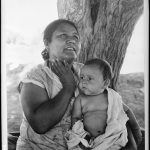Mexican mother in California. “Sometimes I tell my children that I would like to go to Mexico, but they tell me ‘We don’t want to go, we belong here.'” (Note on Mexican labor situation in repatriation.) June 1935. From Library of Congress Prints and Photographs. http://www.loc.gov/pictures/resource/fsa.8b26837/?co=fsa
In June of 1935, well into the Great Depression, Dorothea Lange photographed a mother and her child in California. The mother talked about how she contemplates moving her and her children to Mexico, perhaps for
better economic opportunities given the impact of the Great Depression in the United States at the time. Taken straight on, the photo almost looks planned as if the mother wanted a portrait for memories. We can assume the photographer was greatly interested in representation and illustrating diverse perspectives on the Great Depression, because most publications of this era focused on how it impacted the typical white man in America, and specifically those living in New York near Wall Street itself. This photographer however, heard from a Mexican woman on the other side of America to show how this event effects people who might not have been given a voice otherwise. This photo represents the Great Depression by giving a light to more marginalized groups and you can see the direct effects from this era. The baby wears a scrap of material as clothes. The mother seems tired, but hopeful. You can tell she has been thinking about what she needs to do to best help her children, as well as working to provide the best she can. Her clothes seem to be dirty, showing that she works and may not have as much time to worry about herself as she does for her family. Dorothea Lange captured a glimpse into what life for more marginalized groups of women during the Great Depression held. In the image they captured, one can see the determination, indurance, and hope a mother has in order to persevere for her family through the greatest adversities.
